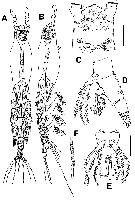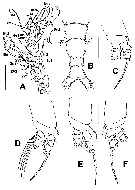|
|
 |
Fiche d'espèce de Copépode |
|
|
Monstrilloida ( Ordre ) |
|
|
|
Monstrillidae ( Famille ) |
|
|
|
Cymbasoma ( Genre ) |
|
|
| |
Cymbasoma alvaroi Suarez-Morales & Carillo , 2013 (F) | |
| | | | | | | Ref.: | | | Suarez-Morales & al., 2013 (p.631, Descr.F, figs.F, Rem.) |  Issued from : E. Suarez-Morales, A. Carillo & A. Morales-Ramirez in J. Nat. Hist., 2013, 47 (5-12). [p.632, Fig.6]. Female (from Cahuita, Costa Rica): A-B, habitus (dorsal and lateral, respectively); C, cephalic area (ventral), showing cuticular processes and ornamentation; D, urosome (lateral), showing lateral process on distal margin of genital double-somite; E, 5th pedigerous and genital somites (ventral). Scale bars: 250 µm (A, B); 100 µm (C-E). Nota: Oral papilla located 0.27 of the way back along cephalothorax. A1 short 18% of total body length. Forehead with medial rounded process between antennule bases. Inner seta of P5 shorter and thinner than the other two setae. Inner lobe of P5 not reaching half the length of outer lobe. Proximal half of genital double-somite rounded. Anal somite with ridged margins.
|
 Issued from : E. Suarez-Morales, A. Carillo & A. Morales-Ramirez in J. Nat. Hist., 2013, 47 (5-12). [p.634, Fig.7]. Female: A, right A1 (dorsal), showing armature following nomenclature by Grygier & Ohtsuka (1995); B, urosome (dorsal), caudal setae cut short; C, P1 (dorsal); D, P2 (dorsal); E, P3 (dorsal), with longer basipodal seta; F, P4 (dorsal). Most setae of P1-P4 cut short. Scale bars: 100 µm (A-F).
|
 Issued from : E. Suarez-Morales, A. Carillo & A. Morales-Ramirez in J. Nat. Hist., 2013, 47 (5-12). [p.635, Table 3]. Female: Formula armature of swimming legs P1 to P4. Spines denoted by Roman numerals, setae by Arabic numerals from outer margin of any segment given first, separated by a hyphen from the inner margin.
| | | | | NZ: | 1 | | |
|
Carte de distribution de Cymbasoma alvaroi par zones géographiques
|
| | | | Loc: | | | Caribbean Sea (Cahuita, SE Costa Rica reef) | | | | N: | 1 | | | | Lg.: | | | (1120) F: 1,74; {F: 1,74} | | | | Rem.: | For Suarez-Alvarez & al. (2013, p.635) the Cahuita’s female is easily assigned to the genus Cymbasoma by its possession of 3 caudal setae and the presence of 3 urosomites (5th pedigerous, genital double-somite and anal somite). Most of the known species of Cymbasoma have P5 bearing an inner lobe, developed in different degrees ; two main groups with this charcter have been defined within the genus, one related to Cymbasioma longispinosum (Bourne, 1890) and the other to Cymbasoma rigidum thompson, 1888. Only a reduced group of species have P5 with a single lobe armed with 3 setae. The first group, related to C. longispinosum, shares a relatively long cephalothorax (representing more than 55% of the total body length), a biramous P5 with a relatively reduced inner lobe, an outer lobe with 3 setae, and a well-developed genital double-somite.
The new species appears to be most closely related to C. germanicum (redescibed by Suarez-Morales, 2006) from Helgoland, and to C. davisi from Florida (Suarez-Morames & Pilz, 2008). The general body proportions and the characters of the antennular armature, the genital double-somite and P5 are almost identical in the three species. They also share a distinctive lateral process on the distal margin of the genital double-somite, a field of dorsal cuticular ridges on the same somite, and basally separated ovigerous spines. There are several differences between these species : in C. alvaroi the relative length of the cephalothorax is 61% of the total body length, whereas both C. germanicum and C. davisi have a relatively shorter cephalothorax (57%). The position of the oral papilla is different in these species : 26.8% of the way back along cephalothorax in C. alvaroi versus 23% in C. davisi and C. germanicum. The anal somite has ridged margins in C. davisi an dit is smooth in C. alvaroi and C. gemanicum. C. alvaroi has a rounded process on the forehead area between the antennule bases, a character absent in both C. gemanicum and C. davisi. | | | Dernière mise à jour : 02/01/2015 | |
|
|
 Toute utilisation de ce site pour une publication sera mentionnée avec la référence suivante : Toute utilisation de ce site pour une publication sera mentionnée avec la référence suivante :
Razouls C., Desreumaux N., Kouwenberg J. et de Bovée F., 2005-2025. - Biodiversité des Copépodes planctoniques marins (morphologie, répartition géographique et données biologiques). Sorbonne Université, CNRS. Disponible sur http://copepodes.obs-banyuls.fr [Accédé le 31 décembre 2025] © copyright 2005-2025 Sorbonne Université, CNRS
|
|
 |
 |





